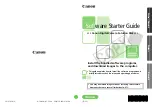
Increase the DirectX buffering size
1.
Open the Acoustic Mirror dialog.
2.
Right-click an empty area of the dialog outside of the four tabs and choose
Configuration
from the shortcut menu. The Real-Time
Preview Configuration dialog is displayed.
3.
Reconfigure the
Buffers to process per second
and
Total playback buffers
controls. Typically, lowering the
Buffers to process per
second
value and increasing the
Total playback buffers
value reduces gapping during real-time previewing.
Close all memory-intensive applications
Real-time previewing may be limited by any additional applications operating on the desktop. To avoid this situation, close all memory-
intensive applications prior to using this effect.
Add additional RAM to the system
We require at least 512 MB of RAM to operate Sound Forge software and its related tools.
Add a faster floating point arithmetic processor
Many high-speed processors are still lacking in speed when processing floating point arithmetic. We recommend using high-speed
processors that provide exceptional floating point arithmetic for reliable real-time previewing.
Impulses do not recover properly
If you experience problems recovering custom impulse recordings, verify each of the following:
1.
Verify that you have trimmed the recorded test tone based on the mode chosen from the
Impulse recovery mode
drop-down list.
2.
Verify that the second spike is present in the recorded test tone if the
Auto-detect timing spikes
options is specified.
3.
Verify that the file specified in the
Test file used
box is the exact test tone used to make to field recording and that neither its length
or data has been changed.
4.
If the impulse still does not recover properly in
Auto-detect timing spikes
mode, normalize the spikes in the recorded test tone file.
This should aid the auto-detect algorithm in detecting the timing spikes and recovering the impulse.
Recovered impulse is too noisy
To maximize the impulse’s signal-to-noise ratio, you should verify that the field recording’s noise floor is not too high. When recording in
noisy environments, increase the test tone’s amplitude until the test tone is at least 25 dB louder than the noise floor. At least 40 dB of
signal-to-noise is recommended for optimal impulses. If you cannot avoid noise when recording in the field, the Noise Reduction tool
can salvage a session.
Speaker nonlinear distortion can also cause noisy impulses. The most common source of nonlinear distortion is loudspeaker harmonics.
Most speakers display substantial harmonic distortion at low frequencies. For example, when you play a 60 Hz tone, the speaker vibrates
at 60 Hz, but also outputs lower-level audio at multiples of 60 Hz (120, 180, etc.). The impulse recovery method greatly minimizes these
low-frequency distortions; however, inexpensive tweeters often display substantial high-frequency distortion that can disrupt the
recovery process. When possible, use high-quality components and do not overdrive the speakers.
Error message explanations
The following sections briefly describe Acoustic Mirror error messages that you may encounter.
The selected file is not a valid test file
The file specified in the
Test file used
box is not a test tone file included on the Sound Forge application disc.
USING ACOUSTIC MIRROR AND WAVE HAMMER
|
225
Summary of Contents for Pro 10
Page 1: ...Pro 10 Sound Forge User Manual ...
Page 2: ......
Page 26: ...20 CHAPTER 1 ...
Page 60: ...54 CHAPTER 2 ...
Page 152: ...146 CHAPTER 8 ...
Page 166: ...160 CHAPTER 9 ...
Page 176: ...170 CHAPTER 10 ...
Page 200: ...194 CHAPTER 11 ...
Page 220: ...214 CHAPTER 12 ...
Page 236: ...230 CHAPTER 13 ...
Page 266: ...260 CHAPTER 16 ...
Page 278: ...272 CHAPTER 17 ...
Page 312: ...306 CHAPTER 20 ...
Page 346: ...340 APPENDIX C ...
Page 366: ...360 APPENDIX E ...
















































